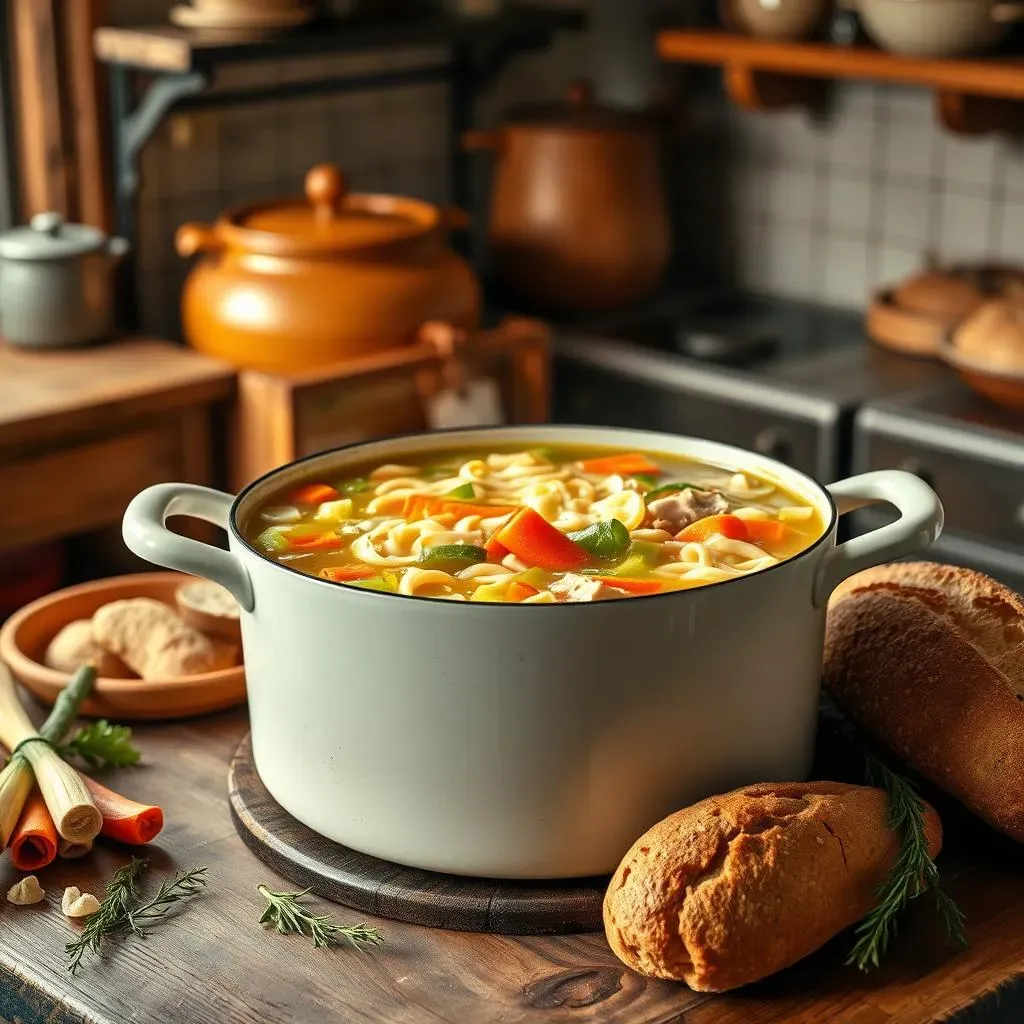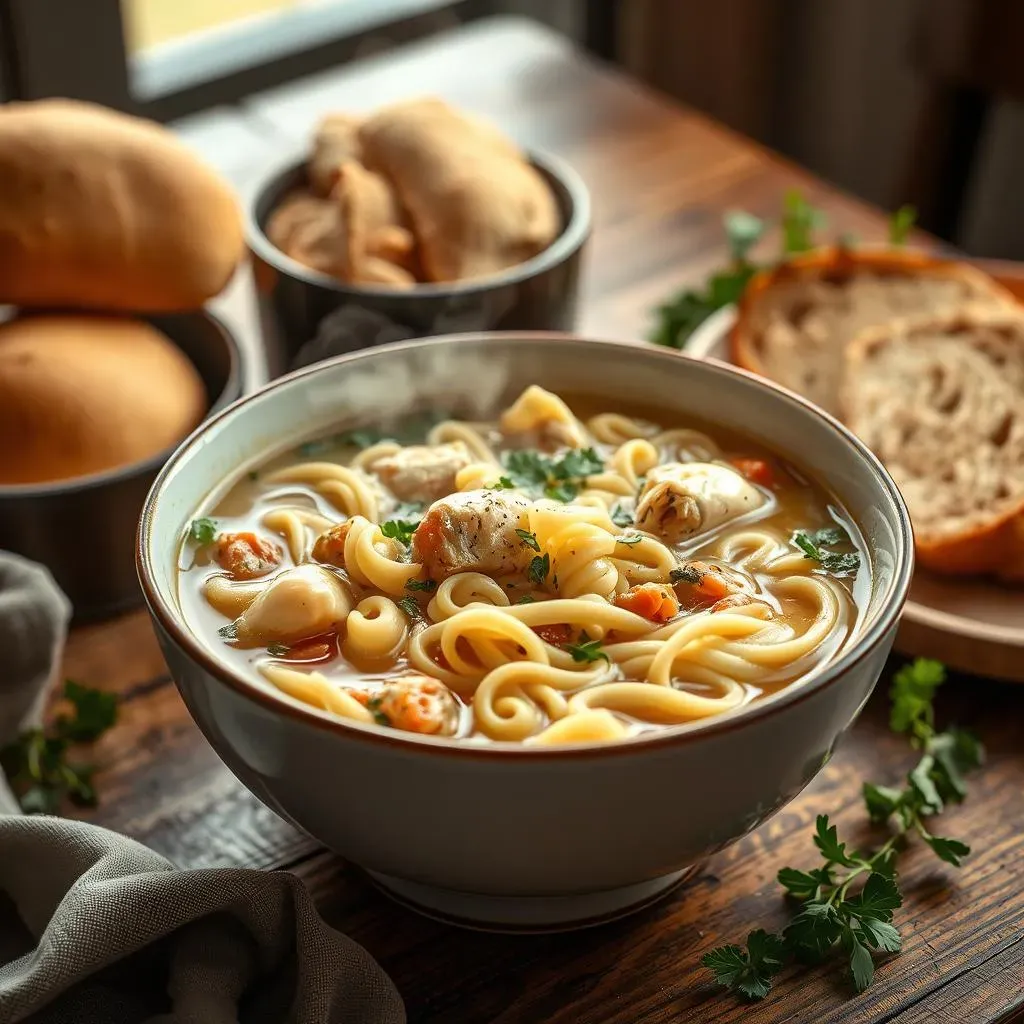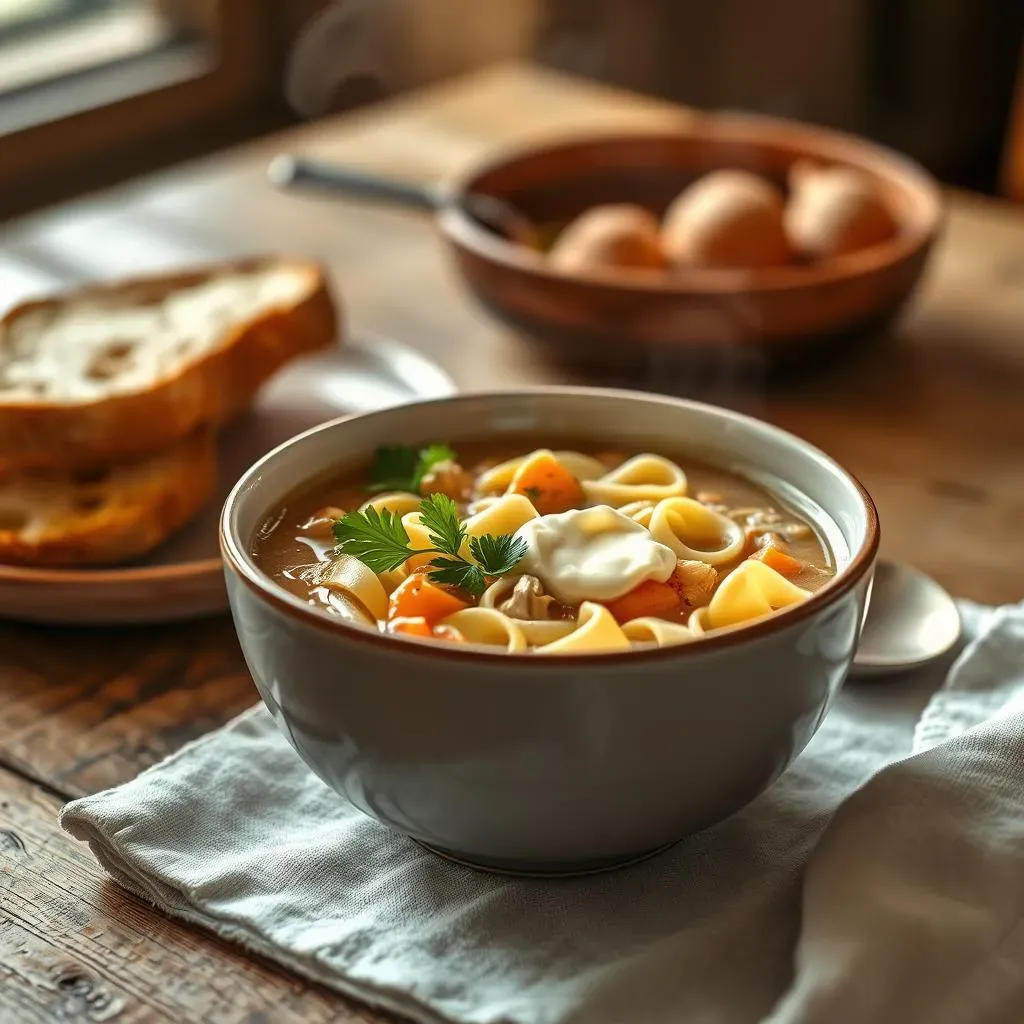Table of Contents
Craving a taste of home, a spoonful of comfort, or a remedy for the winter blues? Look no further than Oma's Hühner-Nudelsuppe – a traditional German chicken noodle soup recipe that's more than just a meal; it's a warm hug in a bowl. This isn't your average, run-of-the-mill soup; it's a flavorful journey back to simpler times, filled with the rich aroma of homemade broth and the satisfying slurp of perfectly cooked noodles. It’s a dish steeped in family tradition, passed down through generations, and now, ready to grace your table.
The Heart of HühnerNudelsuppe: Crafting the Perfect Broth for German Chicken Noodle Soup

The Heart of HühnerNudelsuppe: Crafting the Perfect Broth for German Chicken Noodle Soup
The Foundation: Choosing Your Chicken
Let’s get real: the broth is where the magic happens in any good chicken noodle soup, and Oma's German version is no exception. The secret? Don't skimp on the chicken! While you can use pre-cut chicken pieces, I highly recommend starting with a whole chicken or, at the very least, bone-in, skin-on chicken parts like thighs and drumsticks. Why? Because those bones and skin are packed with collagen, which breaks down during simmering to create a rich, flavorful, and slightly gelatinous broth – that's the good stuff!
Think of it like this: you're not just making soup, you're extracting the very essence of chicken-y goodness. And don't worry about the cost; using a whole chicken is often more economical than buying individual pieces. Plus, you'll have plenty of cooked chicken left over to shred and add back into the soup, or to use in another delicious meal. Two birds with one stone, or rather, two meals with one chicken!
The Aromatic Symphony: Vegetables and Spices
Alright, you've got your chicken, now it's time to build that flavor profile! This isn't just about throwing in any old veggies; we're talking about creating a symphony of aromas that will tantalize your taste buds. The classic German approach, and what Oma would insist on, involves using what's called "Suppengrün," which typically includes carrots, celery root (or regular celery if you can't find the root), leeks, and onions. These veggies provide a sweet, earthy, and savory base for the broth.
But don't stop there! A few peppercorns, a bay leaf or two, and maybe a pinch of allspice can add subtle layers of complexity. And if you're feeling adventurous, a small piece of ginger can provide a lovely, warming note. Remember, we're aiming for a broth that's flavorful enough to stand on its own, but not so overpowering that it overshadows the other ingredients. It's a delicate balance, but trust your taste buds and don't be afraid to experiment!
Ingredient | Purpose | Oma's Tip |
|---|---|---|
Chicken Bones | Richness, Collagen | Simmer bones for 4 hours after removing chicken for deeper flavor. |
Carrots, Celery, Leeks, Onion | Flavor Base | Don't overcook; they should still have some texture. |
Peppercorns, Bay Leaf, Allspice | Aromatic Complexity | Use sparingly; a little goes a long way. |
From Oma's Garden: Selecting Vegetables for Authentic German Chicken Noodle Soup

From Oma's Garden: Selecting Vegetables for Authentic German Chicken Noodle Soup
The Suppengrün Standard: Carrots, Celery, Leeks, and Onions
so you've got your broth simmering away, filling your kitchen with that irresistible aroma. Now, let's talk veggies! When it comes to authentic German chicken noodle soup, or Hühner-Nudelsuppe, there's a quartet of vegetables that Oma would absolutely insist on: carrots, celery (or celery root, if you can find it), leeks, and onions. This combination, known as "Suppengrün," forms the aromatic foundation of the soup, adding sweetness, earthiness, and a subtle savory depth.
Don't underestimate the power of these humble vegetables! They're not just there for texture; they release their flavors into the broth, creating a complex and nuanced taste that's far greater than the sum of its parts. Plus, they provide essential vitamins and minerals, making your soup not only delicious but also nutritious.
Beyond the Basics: Adding Your Personal Touch
While Suppengrün is the traditional base, don't be afraid to get creative and add your own personal touch! Oma wouldn't mind, as long as you're adding love and intention to the pot. Consider including other seasonal vegetables like parsnips, turnips, or even a handful of fresh herbs like parsley or dill. These additions can add subtle variations in flavor and texture, making each batch of soup unique.
Just remember to choose vegetables that complement the overall flavor profile of the soup. Avoid anything too overpowering or bitter, as it could throw off the balance. And always opt for fresh, high-quality ingredients whenever possible; they'll make a world of difference in the final taste.
Prep Like a Pro: Cutting and Cooking Your Vegetables
Alright, you've selected your vegetables, now it's time to prep them like a pro! The key here is to cut the vegetables into uniform sizes so they cook evenly. I like to dice the carrots, celery, and onions into small, bite-sized pieces, and slice the leeks into thin rounds. This ensures that they'll cook through in the same amount of time and distribute their flavors evenly throughout the soup.
When it comes to cooking the vegetables, don't overdo it! You want them to be tender-crisp, not mushy. Add them to the broth about halfway through the simmering process, so they have enough time to release their flavors but still retain some texture. And remember to taste as you go, adjusting the seasoning as needed. After all, cooking is an art, not a science, and the best soups are the ones that are made with love and attention!
Vegetable | Preparation | Flavor Contribution |
|---|---|---|
Carrots | Diced | Sweetness, Color |
Celery (or Celery Root) | Diced | Earthy, Savory |
Leeks | Sliced | Mild Onion Flavor |
Onions | Diced | Aromatic Base |
Noodle Nirvana: Choosing the Right Noodles for Your German Chicken Noodle Soup Recipe

Noodle Nirvana: Choosing the Right Noodles for Your German Chicken Noodle Soup Recipe
The Classic Choice: Egg Noodles (Eiernudeln)
Alright, let's talk noodles! This is where things get really interesting, because the type of noodle you choose can significantly impact the overall texture and mouthfeel of your German chicken noodle soup. While there are many options out there, the classic choice, and what Oma would undoubtedly recommend, is egg noodles, or "Eiernudeln" in German. These noodles are made with eggs, flour, and a touch of salt, resulting in a rich, slightly chewy texture that's perfect for soaking up all that delicious broth.
Egg noodles come in various shapes and sizes, from thin and delicate to wide and hearty. For Hühner-Nudelsuppe, I prefer medium-width egg noodles, as they strike a good balance between being substantial enough to hold their own in the soup, but not so thick that they become overwhelming. You can find egg noodles at most grocery stores, either fresh, dried, or frozen. If you're feeling ambitious, you can even make your own from scratch! Just be warned, it's a bit of a labor of love, but the results are well worth the effort.
Beyond Egg Noodles: Exploring Other Options
While egg noodles are the traditional choice, don't be afraid to experiment with other types of noodles! Oma wouldn't want you to limit yourself. For a gluten-free option, you could try rice noodles or gluten-free pasta. If you're looking for a heartier soup, consider using spaetzle, a type of German dumpling that's similar to noodles. Or, for a fun twist, you could even add small pasta shapes like ditalini or orzo.
The key is to choose a noodle that you enjoy and that complements the other flavors in the soup. Just be mindful of the cooking time, as different types of noodles will cook at different rates. You want the noodles to be tender but not mushy, so keep a close eye on them and taste as you go. And remember, there are no hard and fast rules when it comes to noodles; it's all about finding what works best for you!
Noodle Type | Texture | Flavor Compatibility |
|---|---|---|
Egg Noodles (Eiernudeln) | Chewy, Rich | Classic Choice, Versatile |
Rice Noodles | Soft, Delicate | Gluten-Free Option, Light Flavor |
Spaetzle | Hearty, Dumpling-like | Adds Substance, German Twist |
Cooking Your Noodles: The Perfect Al Dente
Now that you've chosen your noodles, it's time to cook them to perfection! The key here is to cook them "al dente," which means "to the tooth" in Italian. This means that the noodles should be firm and slightly resistant when you bite into them, not mushy or overcooked. To achieve this, follow the cooking instructions on the package, but start checking for doneness a few minutes before the recommended time.
Once the noodles are cooked to your liking, drain them immediately and rinse them with cold water to stop the cooking process. This will also prevent them from sticking together. Then, add them to the soup just before serving, so they don't have a chance to get overcooked. And that's it! You're now a noodle master, ready to create the perfect bowl of German chicken noodle soup!
Serving Suggestions and Variations: Elevating Your German Chicken Noodle Soup Experience

Serving Suggestions and Variations: Elevating Your German Chicken Noodle Soup Experience
A Classic Presentation: Garnishes and Sides
Alright, you've got your Hühner-Nudelsuppe simmering away, the noodles are perfectly al dente, and the aroma is making your stomach rumble. Now, let's talk presentation! Because even the most delicious soup can benefit from a little visual appeal. A classic garnish for German chicken noodle soup is a sprinkle of fresh parsley or dill. These herbs add a pop of color and a burst of freshness that complements the rich flavors of the broth and vegetables.
But don't stop there! A squeeze of lemon juice can brighten up the soup and add a touch of acidity. Or, for a bit of heat, try a pinch of red pepper flakes. As for sides, crusty bread is always a welcome addition, perfect for soaking up every last drop of that delicious broth. And if you're feeling fancy, a dollop of sour cream or crème fraîche can add a creamy, tangy element that's simply divine.
Variations on a Theme: Customizing Your Soup
So, you've mastered the basic German chicken noodle soup recipe, but what if you want to mix things up a bit? Oma would encourage you to get creative and experiment with different variations! For a heartier soup, try adding shredded cooked chicken, leftover from making the broth. Or, for a vegetarian option, simply omit the chicken and use vegetable broth instead. You can also add other vegetables like spinach, kale, or mushrooms.
Another fun twist is to add different types of noodles, such as spaetzle or small pasta shapes. And if you're feeling adventurous, you could even try adding a splash of white wine or sherry to the broth for an extra layer of flavor. The possibilities are endless! Just remember to taste as you go and adjust the seasoning as needed. And most importantly, have fun and make it your own!
Variation | Key Ingredient/Change | Flavor Profile |
|---|---|---|
Hearty Chicken | Shredded Cooked Chicken | More Substantial, Protein-Rich |
Vegetarian | Vegetable Broth (No Chicken) | Lighter, Vegetable-Forward |
Spinach & Mushroom | Spinach, Mushrooms | Earthy, Nutritious |
Savoring Tradition: Your German Chicken Noodle Soup Journey
From simmering the perfect broth to selecting the freshest vegetables and noodles, you've now unlocked the secrets to crafting an authentic German chicken noodle soup recipe. This Hühner-Nudelsuppe is more than just a dish; it's a taste of home, a connection to tradition, and a comforting reminder of simpler times. So, gather your loved ones, ladle up a warm bowl, and savor the rich flavors and heartwarming memories that this classic soup brings. Guten Appetit!
